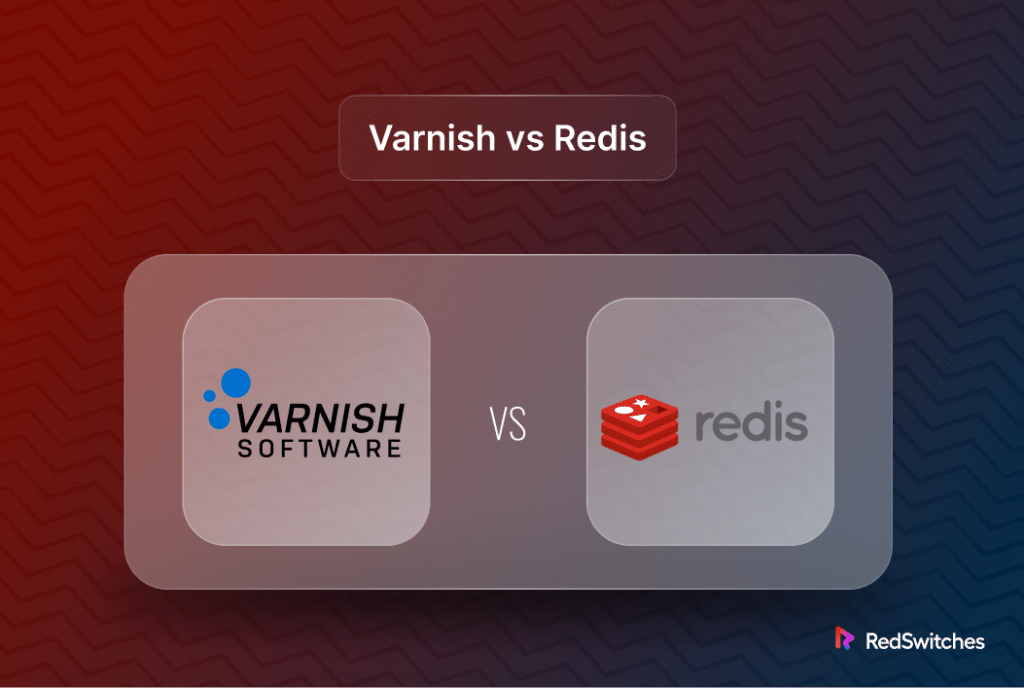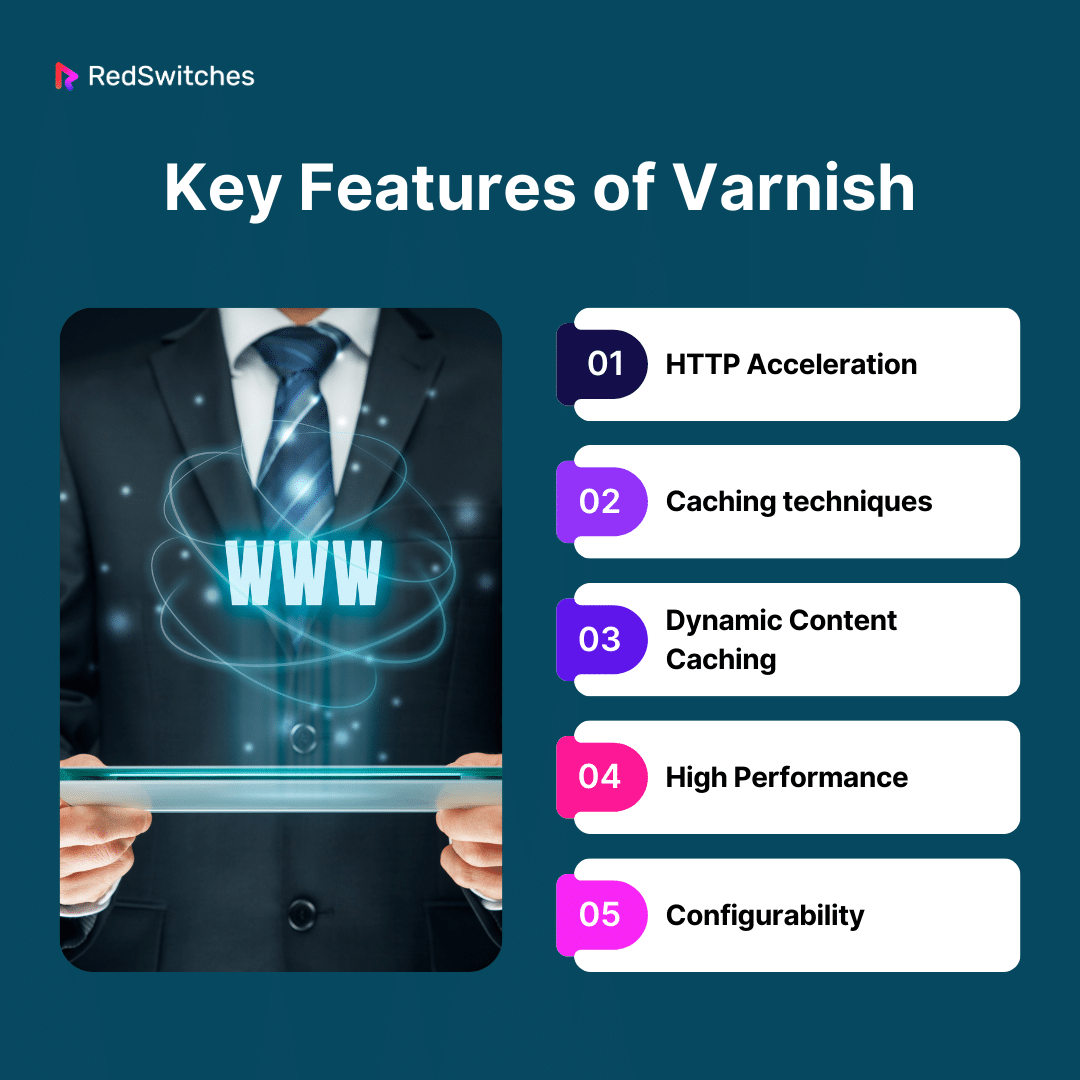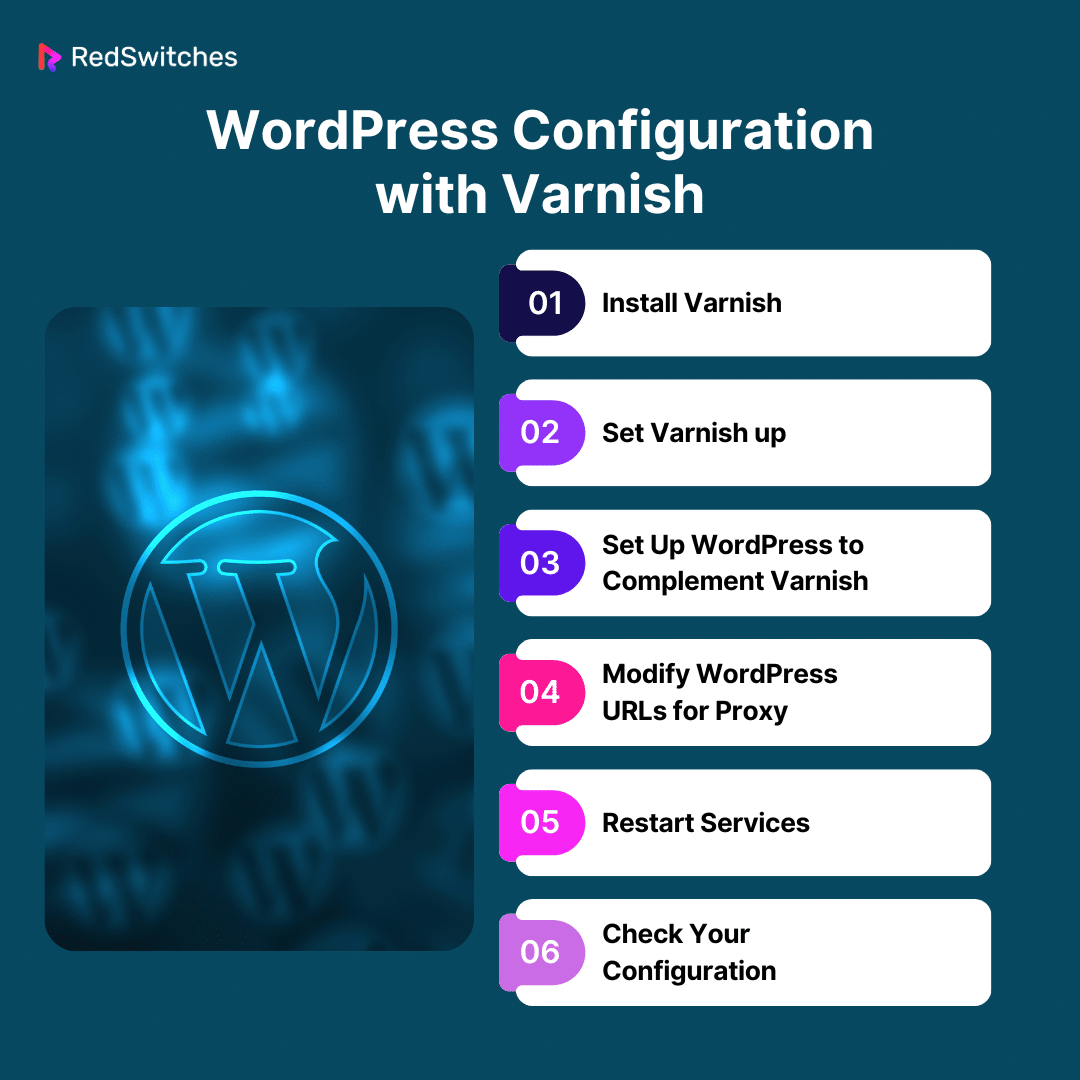Welcome to the battleground where data retrieval and caching collide with speed and storage! The Varnish vs Redis argument is a hot topic in the fast-paced field of web optimization. Imagine Redis as the powerful weightlifter, showing its muscles in the data storage industry, and Varnish as the nimble sprinter, ready to deliver cached content quickly.
As we embark on our adventure, we will break down these dynamic tools’ mysteries into the top 10 essential differences in the Varnish vs Redis debate. So grab a seat and prepare for an exciting journey through performance, efficiency, and speed as we unravel the mystery of Varnish vs Redis.
Table of Contents
- What is Varnish?
- What is Redis
- WordPress Configuration with Varnish
- Key Differences: Varnish vs Redis
- Varnish vs Redis: Data Storage
- Varnish vs Redis: Data Structure
- Varnish vs Redis: Use Cases
- Varnish vs Redis: HTTP Optimization
- Varnish vs Redis: Storage Capacity
- Varnish vs Redis: Configuration Complexity
- Varnish vs Redis: Data Integrity
- Varnish vs Redis: Scalability
- Varnish vs Redis: Real-Time Processing
- Varnish vs Redis: Geographical Distribution
- How to Choose Between Varnish vs Redis
- Conclusion: Redis vs Varnish
- FAQs
What is Varnish?
Credits: Freepik
Reverse proxy server and HTTP accelerator Varnish is a potent and popular tool that dramatically boosts website and online app performance. By efficiently caching and providing static or dynamic material, Varnish handles requests by getting in the way between the client (such as a web browser) and the web server.
Varnish determines if a cached version of a webpage exists when a user accesses it. If so, Varnish can forward the user’s request directly to the web server and provide the cached content, which will speed up response times. This improves user experience overall while reducing the strain on the web server.
Varnish is renowned for being scalable and configurable, enabling administrators to modify its behavior to meet certain requirements. It is especially helpful for large content platforms, high website traffic, and any setting where performance depends on reducing server load and response times.
Key Features of Varnish
Now, we will understand Vanish’s critical features in detail.
HTTP Acceleration
Varnish is positioned between the client and the web server and acts as a reverse proxy. Its primary purpose is to speed up HTTP queries by providing static content straight out of memory and caching it. Users experience faster response times as the web server handles requests less frequently.
Caching techniques
Advanced caching techniques can be defined by administrators using Varnish. Rules for what content should be cached, how long it should be cached (time-to-live), and when the cache should be updated or invalidated can all be specified. This adaptability makes it possible to adjust to the unique requirements and features of the online application.
Dynamic Content Caching
Varnish was first developed to cache static content effectively, and since then it has expanded to include dynamic content. This versatility makes it suitable for various online applications, even in situations where content is updated often.
High Performance
Varnish, known for its remarkable swiftness and effectiveness delivers material with minimal latency and effectively manages many concurrent connections. This high-performance feature is very helpful for websites and applications that must serve content quickly and have high traffic.
Configurability
Varnish’s configuration language, VCL (Varnish Configuration Language), gives administrators great control over how the program behaves. This allows Varnish to be tailored to the unique needs of the web application.
Pros and Cons of Varnish
Pros of Varnish
Having discussed the key features, now let us discuss the pros of Varnish in detail.
- Improved Online Performance
Varnish significantly increases online performance by lowering latency, lightening the strain on web servers, and caching and providing static information. Users receive faster reaction times, which enhances their surfing experience overall.
- Effective Management of High Traffic
Varnish is well-known for its remarkable speed and effectiveness and can manage numerous connections simultaneously. As a result, it works well for websites and applications that experience huge traffic levels, as the infrastructure can easily handle large loads.
- Customizable Caching Strategies
Varnish’s VCL (Varnish Configuration Language) offers a high level of caching control. Custom caching strategies can be defined by administrators, who can set guidelines for what content should be cached, for how long, and when to refresh or expire the cache. This adaptability enables optimization for particular application needs.
- Dynamic Content Caching
Beyond static content, Varnish was created with the ability to cache dynamic content. Because of its versatility, it is a powerful tool for various online applications and operates well even with constantly changing material.
- Load Balancing Capabilities
Varnish may distribute incoming requests equally among several backend servers through load balancing. This guarantees the best possible use of available resources, improves fault tolerance, and makes the system more dependable and scalable.
Cons of Varnish
We will now discuss the Cons of Varnish.
- The Learning Curve
Varnish configuration and optimization could have a more demanding learning curve, particularly for people unfamiliar with its configuration language (VCL). It could take some time and experience to become proficient with Varnish’s capabilities and the granular control it offers.
- Difficulties with Dynamic Material
Varnish is developed to manage dynamic material, but caching pages containing personalized or constantly changing data might present additional difficulties. In these kinds of situations, using suitable cache invalidation techniques becomes essential.
- Resource-Intensive
While Varnish excels at performance improvement, it utilizes a lot of memory and other system resources. Memory may be more in demand in configurations with heavy caching or high-traffic websites, which could affect the server’s overall performance.
Also read Redis vs Memcached: 15 Key Differences You Should Know
- Configuration Complexity
Varnish’s tremendous configurability also has the potential to cause complexity. It takes careful attention to adjust cache rules and manage the VCL setup; incorrect configurations can cause unexpected behavior or negatively affect performance.
- Absence of Built-in SSL/TLS Support
Varnish lacks built-in support for encrypted connections, even though it can handle SSL/TLS termination. This needs more parts to manage secure connections, like a different SSL/TLS termination proxy.
What is Redis?
Credits: Freepik
Redis is an open-source, high-performance key-value database that operates as an in-memory data structure store. Redis is a C-language program renowned for its simplicity, speed, and adaptability. It is widely used for many applications, such as caching, real-time analytics, messaging systems, and more, since it offers a quick and effective way to store, retrieve, and alter data.
Redis has a robust publish/subscribe (pub/sub) messaging mechanism that expands its functionality beyond a traditional key-value store. This feature lays the groundwork for event-driven architectures by facilitating real-time communication through channels between various components of an application or dissimilar apps.
Another essential component of Redi’s functioning is its atomic operations. Data consistency in multi-step operations is maintained via the support for atomic operations, guaranteeing that certain operations are carried out as indivisible pieces.
Key Features of Redis
After discussing what exactly Redis is, we will now understand the Key Features of Redis.
In-Memory Data Storage
Redis uses the computer’s main memory (RAM) to store all of its data, allowing for incredibly quick read and write times. This in-memory architecture allows for incredibly fast data access and manipulation, resulting in significant performance gains for applications.
Key-Value Store
Redis functions fundamentally as a key-value store. Unique keys organize and retrieve data, each with a corresponding value. This simple and efficient structure makes Redis appropriate for various use cases.
Data Types
Redis offers a rich set of data structures beyond basic key-value pairs. This includes bitmaps, texts, lists, sets, sorted sets, hashes, and geographic indexes. Because of this flexibility, developers can model and work with data differently within the same database.
Persistence Options
Redis provides persistence options for data durability even though it is an in-memory store. Administrators can ensure that data is recoverable in case of a system restart by configuring append-only files or periodic snapshots to log changes.
Pub/Sub Messaging
Redis has a publish/subscribe (pub/sub) messaging system that enables real-time channel communication between various components of an application or between numerous applications. This messaging pattern underpins event-driven architectures, where components react to specific events as they occur.
Pros and Cons of Redis
Pros of Redis
In this section, we will deal with the Pros of Redis.
- In-Memory Speed
Redis offers quick read and write times by storing data in the computer’s main memory (RAM). This in-memory design is perfect for applications that need low-latency answers since it provides fast access to data.
- Versatile Data Types
Redis goes beyond basic key-value pairs with a rich set of data structures. It can handle various data types, such as bitmaps, texts, lists, sets, sorted sets, hashes, and geographic indexes. Because of this adaptability, developers can represent and work with data in various ways inside a single database.
- High Throughput
Redis can process many transactions per second because of its in-memory architecture and effective data structures. Because of this, it works effectively in situations where throughput needs are high.
- Atomic Actions
Redis guarantees that certain actions are carried out as indivisible units by supporting atomic operations on its data types. Because of its atomicity, multi-step processes are guaranteed to be consistent, improving data reliability and integrity.
- Pub/Sub Messaging
Redis has a publish/subscribe (pub/sub) messaging system that allows channel-based real-time communication across various application components or disjointed apps. This facilitates the creation of event-driven and responsive structures, where components react to specific events as they occur, promoting loose coupling and responsive applications.
Cons of Redis
- Volatility of In-Memory Storage
Redis is vulnerable to data loss in case of a system failure or restart as it relies on in-memory storage, which does not automatically store data to disc. Although there are alternatives for persistence, they might cause more complications.
- Memory Consumption
The quantity of RAM available can be a constraint as Redis runs mostly in memory. Massive dataset storage could need a lot of memory, raising the cost of infrastructure or hosting.
- Complexity of Persistence Configuration
While in-memory storage offers superior speed, Redis provides persistence options, even though it is complicated to set up and maintain. Administrators must carefully examine and set up suitable persistence mechanisms, such as append-only files or snapshots, to guarantee data longevity.
- Single-Threaded Nature
Redis has historically used a single-threaded event loop approach, prioritizing simplicity and efficiency. The system’s capacity to fully utilize multi-core processors may be limited by this design, which could hinder performance in highly concurrent settings even while consistency is made simpler.
- Limited Query Language
Unlike conventional relational databases, Redis does not support complicated query languages. This simplicity might be a drawback for applications requiring sophisticated querying capabilities, particularly for complicated data linkages.
Also read Mastering SQL NOT IN and IN Operators: Enhance Your Query Skills
WordPress Configuration with Varnish
Before moving into the core debate topic of Varnish vs Redis, we will understand the WordPress configuration steps with Varnish.
Install Varnish
Verify that your server has Varnish installed. Your operating system may have different requirements for the installation process. For instance, on a system running Debian or Ubuntu, you can use.
# sudo apt-get update
# sudo apt-get install varnish
Set Varnish up
By adjusting its configuration, you can specify how Varnish communicates with your WordPress website. The Varnish configuration file is normally found at /etc/varnish/default.vcl. Make necessary changes to this file to make it compatible with your WordPress system.
Here’s a simple illustration to get you going:
backend default {
.host = "127.0.0.1";
.port = "8080";
}
sub vcl_recv {
if (req.url ~ "/wp-admin|wp-login.php") {
return (pass);
}
if (req.url ~ "\.(png|gif|jpg|swf|css|js)$") {
return (lookup);
}
return (hash);
}
Set Up WordPress to Complement Varnish
Modify your WordPress setup so that Varnish functions properly. Upon opening your wp-config.php file, include the following lines to specify the port and backend server:
define('VARNISH_CTR', '127.0.0.1');
define('VARNISH_PORT', '8080');
Modify WordPress URLs for Proxy
Varnish may need you to modify WordPress URLs in certain circumstances. WordPress may create URLs containing the reverse proxy’s IP address (such as Varnish) if your WordPress website is behind one. To fix this, include the following lines in your wp-config.php file:
if (isset($_SERVER['HTTP_X_FORWARDED_PROTO']) && $_SERVER['HTTP_X_FORWARDED_PROTO'] == 'https') {
$_SERVER['HTTPS'] = 'on';
}
if (isset($_SERVER['HTTP_X_FORWARDED_FOR'])) {
$ips = explode(',', $_SERVER['HTTP_X_FORWARDED_FOR']);
$_SERVER['REMOTE_ADDR'] = $ips[0];
}
Restart Services
After making these adjustments, you should restart your web server and Varnish. The operating system of your server will determine the precise commands. For instance, on a system running a Debian-based distribution:
# sudo service varnish restart
# sudo service apache2 restart
Check Your Configuration
Go to your WordPress website and make sure everything loads properly. You may also look at the response headers to ensure Varnish serves the material. You can use programs like curl or browser extensions to examine HTTP headers.
Three Best Practices of Varnish with WordPress
Before moving to the ultimate Varnish vs Redis debate, let’s understand Varnish’s three best practices with WordPress.
Keep Admin Pages Out of Caching
WordPress admin pages usually contain dynamic content that shouldn’t be cached to guarantee accurate and real-time changes. Add rules to the Varnish configuration (often located in /etc/varnish/default.vcl) to prevent URLs connected to the WordPress admin interface from being cached. As an illustration:
sub vcl_recv {
if (req.url ~ "^/wp-(login|admin|cron)") {
return (pass);
}
// Additional configuration...
}
Apply Appropriate Cache Invalidation
Dynamic material, such as comments, posts, and user interactions, are common on WordPress websites. Use cache-clearing techniques to ensure the cache is invalidated correctly when content changes. Varnish allows you to clear your cache using HTTP methods such as PURGE. When content is changed or removed from WordPress, you can utilize plugins like “Varnish HTTP Purge” to send purge requests to Varnish.
Improve Static Asset Cache
Use Varnish to cache static resources, such as stylesheets, JavaScript scripts, and images, to lighten the strain on your web server and expedite information delivery. To effectively identify and cache static content, modify the Varnish settings. As an illustration:
sub vcl_recv {
if (req.url ~ "\.(png|gif|jpg|swf|css|js)$") {
return (hash);
}
// Additional configuration...
}
Key Differences: Varnish vs Redis
Finally, we have arrived at the core section of our blog to discuss the Varnish vs Redis debate in detail.
Varnish vs Redis: Data Storage
Credits: Freepik
Varnish
Instead of acting as a comprehensive data store, Varnish’s data storage strategy is focused on caching static information. Varnish’s main job is to intercept and cache HTTP requests so that frequently requested material is served straight from memory, lightening the burden on web servers.
Redis
Redis is an in-memory data structure store that is dynamic and adaptable in data storage. In contrast to Varnish, Redis functions as a comprehensive data store that supports various data types. Redis can handle various storage requirements as it can accommodate strings, lists, sets, hashes, and more.
Varnish vs Redis: Data Structure
Credits: Freepik
Varnish
Going further into the data structure space, Varnish functions mostly as a static content caching solution. It is quite good at effectively storing and serving static assets such as photos and pre-rendered web pages. Administrators can set caching policies and rules using Varnish’s versatile configuration language, VCL (Varnish Configuration Language).
Redis
Unlike Varnish, which focuses on web acceleration, Redis is an extremely flexible and dynamic in-memory data structure storage. Many data types, such as strings, lists, sets, hashes, and more, are supported by Redis, showcasing its efficiency in handling various data structures.
Also read An Introduction To Database: Types, Understanding DBMS & More
Varnish vs Redis: Use Cases
Credits: Freepik
Varnish
Varnish is designed to optimize web performance using reverse proxy caching and HTTP acceleration. Its main application is in the highly effective static content caching and delivery. Varnish distributes content to consumers directly after intercepting HTTP requests and storing it in memory for frequent access.
Redis
Redis is a dynamic and flexible in-memory data store used in many applications throughout the technology industry. It is a favored option for caching in dynamic web applications due to its speed and versatility. It effectively caches frequently accessed data, decreasing the need for repetitive database queries and greatly enhancing response times.
Varnish vs Redis: HTTP Optimization
Credits: Freepik
Varnish
Varnish is a powerful HTTP accelerator specializing in improving web speed via effective content delivery and caching. Its function as a caching reverse proxy underpins its HTTP optimization capabilities. Varnish cleverly caches static content in memory and serves it to consumers directly by intercepting incoming HTTP requests.
Redis
Redis’s capabilities, particularly caching and data storage, greatly aid in HTTP optimization, even if it is not a dedicated HTTP accelerator like Varnish. Redis effectively stores frequently accessed data in memory and is frequently used as a caching layer for dynamic web applications. Its rapid read-and-write operations and versatility in handling data types make it a great option for database query optimization.
Varnish vs Redis: Storage Capacity
Credits: Freepik
Varnish
Varnish has a limited amount of persistent storage space. Varnish usually caches content in volatile memory (RAM) for quicker retrieval. This implies that Varnish is not naturally suited for the long-term or persistent storage of massive datasets, even though it does offer quick access to commonly requested static assets. The server’s RAM capacity limits the amount of storage that can be used.
Redis
On the other hand, Redis is a flexible and dynamic in-memory data structure store that prioritizes data storage. Its scalable technique for managing different kinds of data is based on the RAM available on the server. Redis’s architecture makes it capable of handling a wide range of data structures, from straightforward key-value pairs to more intricate data types like sets, lists, etc.
Varnish vs Redis: Configuration Complexity
Credits: Freepik
Varnish
Administrators can customize caching policies and rules using Varnish’s VCL (Varnish Configuration Language), which provides an adjustable setup for web acceleration and caching. The ability to fine-tune Varnish’s behavior adds moderate complexity, even if the fundamental setups for popular use cases are rather simple.
Redis
Regarding configuration, Redis is well-known for being easier to use than Varnish. It is simple to begin with basic installations because the default configurations are effective in many scenarios.
On the other hand, configuring Redis for particular scenarios—like establishing replication, durability, or optimizing eviction policies—may add a considerable amount of complexity as use cases get more sophisticated.
Varnish vs Redis: Data Integrity
Credits: Freepik
Varnish
Varnish is a reverse proxy and HTTP accelerator mainly used to optimize web performance by effectively caching and delivering static content. Varnish is not built for persistent storage of dynamic data and functions mostly in memory regarding data integrity. Varnish guarantees the precise and effective delivery of content that has been cached; nonetheless, it focuses more on improving web acceleration than it does on offering capabilities to address conventional data integrity issues.
Redis
Redis prioritizes data integrity by supporting atomic operations and providing persistent features. By guaranteeing that specific operations on Redis data types are carried out as indivisible units, atomic operations help avoid inconsistencies resulting from concurrent access.
Varnish vs Redis: Scalability
Credits: Freepik
Varnish
Because Varnish is made to be horizontally scalable, businesses can spread the load among several Varnish instances. This scalability feature is especially useful in settings where web traffic is anticipated to change or increase over time. Organizations may ensure optimal performance and responsiveness by handling growing workloads more efficiently by deploying numerous Varnish instances.
Redis
Redis is a flexible solution for various data storage requirements since it offers both vertical and horizontal scalability possibilities. A single Redis node’s capacity can be increased through vertical scaling, usually by adding more RAM or other resources. Redis Cluster further provides horizontal scalability, enabling data to be spread across several nodes.
Varnish vs Redis: Real-Time Processing
Credits: Freepik
Varnish
Varnish presents components for real-time processing in the context of search engine optimization. One noteworthy characteristic is Edge Side Includes (ESI), a potent mechanism that permits the dynamic construction of web pages from cached fragments. Web developers may incorporate dynamic and static material onto a single page with ESI, improving personalization and real-time updates.
Redis
Redis is an excellent choice for scenarios demanding quick updates and data access because of its flexible feature set and exceptional real-time processing capabilities. With its atomic operations and support for data structures like lists, sets, and sorted sets, developers can create real-time features like leaderboards, message queues, and live analytics.
Varnish vs Redis: Geographical Distribution
Credits: Freepik
Varnish
Varnish can be carefully placed in several different locations to build a distributed caching system. This geographic dispersion lowers user latency in various locations, improving content delivery. Organizations can reduce the time it takes for content to travel over the internet and achieve faster page load times by positioning Varnish instances closer to end consumers.
Redis
Redis is a very strong in-memory data store, yet there are several drawbacks due to its geographical dispersion. Since Redis is typically designed for a master-slave replication paradigm, establishing globally distributed Redis clusters can present challenges, including higher network latency and possible problems with data synchronization.
Also read A Comprehensive Guide to IP Addressing, Subnets, and Subnet Masks
How to Choose Between Varnish vs Redis
Credits: Freepik
After discussing the Varnish vs Redis debate in detail, we will now focus on which one is better.
Choose Varnish If
-
Web Caching and Acceleration
Varnish was created especially to speed up online applications. Varnish is a fantastic option if your main objective is to increase the speed and performance of your web applications by caching static material.
-
HTTP Speed Up
Varnish has been extensively tuned to accelerate HTTP. It is very good at rapidly providing cached content, which lessens the strain on your web servers and speeds up client response times.
-
Caching Edge
Varnish can be installed at the edge of your network and is frequently used as a reverse proxy. Because of this, it works well for caching content closer to end users, which lowers latency and enhances user experience generally.
Choose Redis If
-
Data Retrieval and Storage
Redis is great for storing and retrieving data in key-value pairs because it is essentially a data structure store. Redis is a good option if your application needs an in-memory data store that operates quickly and effectively.
-
Analytics in Real Time
Because Redis is in-memory based, it can handle high-throughput scenarios if your use case requires real-time analytics or data processing. Real-time data processing, session storage, and caching are among its frequent uses.
-
Pub/Sub Messaging
Redis is appropriate for developing event-driven architectures and real-time communication systems since it supports publish/subscribe messaging patterns.
Also Read: How To Install Redis on macOS: 2 Scenarios
Conclusion: Redis vs Varnish
Finally, the Varnish vs Redis argument reveals a subtle decision between two potent instruments designed for specific uses. With its caching solid methods, Varnish is excellent for speeding up web content delivery. Still, Redis is a standout in-memory data store perfect for quickly retrieving key-value pairs. Making an informed choice based on particular project requirements requires understanding the benefits, drawbacks, important features, and important distinctions between them.
It becomes clear as we explore the ever-changing world of web technologies that the best option depends on the particular requirements of each application.
Performance and dependability are critical factors at RedSwitches, where the insights gleaned from this investigation support strategic choices about web infrastructure optimization. We are a dependable partner for advancing digital experiences, whether utilizing the speed of Varnish or the data management expertise of Redis.
FAQs
Q. Which is better, Varnish or Redis cache?
Varnish or Redis cache may be the better option, depending on your requirements. Redis is the best choice for effective in-memory data storage and retrieval, whereas Varnish is great at speeding up online content delivery.
Q. Which is faster, Redis or Varnish?
Redis functions as an in-memory data store, guaranteeing quick access to key-value pairs, making it faster overall. Varnish, on the other hand, uses strong caching methods to optimize the delivery of online content.
Q. How much memory does Varnish use?
Varnish uses a variable amount of RAM depending on workload and setup, although it generally uses system resources efficiently for the best web caching performance.
Q. What is the difference between Varnish cache and Redis cache?
Varnish cache is a web application accelerator and a caching HTTP reverse proxy, whereas Redis cache is an open-source, high-performance in-memory data structure store used as a database, cache, and message broker.
Q. When should I use the Varnish cache?
Varnish cache is often used to optimize website performance by caching and serving static content, thus reducing the load on the web server and improving the overall user experience.
Q. In what scenarios should I use Redis cache?
Redis cache is commonly used to harness concurrency and handle complex data rendering, and can also be configured to use as a message broker or for caching capabilities in an e-commerce or API environment.
Q. Can the Varnish cache and Redis cache be used together?
A: Yes, Varnish cache and Redis cache can be integrated to work together, with Varnish acting as a reverse caching proxy in front of web servers and Redis handling the caching and data storage.
Q. How can I optimize my website using Varnish cache?
To optimize your website with Varnish cache, you can install it in front of your web server and configure it to cache and serve static content, thereby reducing the number of requests and improving load times.
Q. What are some popular plugins or tools for Varnish cache?
Some popular tools and resources for Varnish cache include tutorials on GitHub, integration with Magento 2 for e-commerce platforms, and discussions on its usage and implementation within the StackShare community.
Q. What are the key features of Varnish cache?
Varnish cache is known for its high-performance HTTP accelerator, caching and serving static content, and its ability to significantly improve website performance by a factor of 300 or more.
Q. How is Redis cache also known in the industry?
Redis cache is also known as an in-memory data structure store, often used as a database, caching system, message broker, and for its integration with web applications and APIs.
Q. What are the advantages of using Redis and Varnish cache in a web application stack?
Using Redis cache and Varnish cache in your web application stack can significantly improve performance, reduce the load on the web server, and enhance overall user experience by efficiently caching and serving content.
Q. What are the main differences in the use cases of Varnish cache and Redis cache?
Varnish cache is primarily utilized as a web application accelerator and for optimizing website performance, while Redis cache is often employed for data storage, caching, and message broker purposes in web applications and e-commerce environments.




















